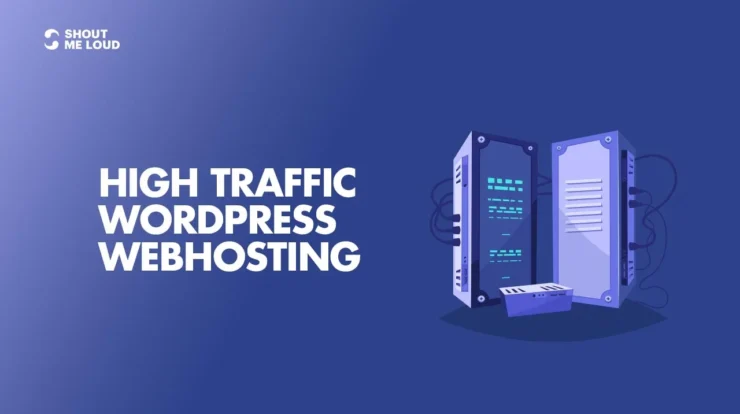
A website’s performance directly impacts user experience and, consequently, its success.
For sites experiencing substantial traffic spikes, reliable hosting is paramount for maintaining speed and avoiding frustrating slowdowns.
This crucial aspect, often overlooked, can lead to significant losses in conversions, customer engagement, and even search engine rankings.
Choosing the optimal hosting for high traffic speed is not just a technical consideration; it’s a critical strategy for maintaining a thriving online presence.
Websites handling a high volume of visitors require hosting solutions designed to accommodate demanding bandwidth requirements and rapid content delivery.
Understanding the specific needs of high-traffic websites is essential for selecting the appropriate best hosting for high traffic speed.
Factors like server response time, network infrastructure, and scalability play a significant role in determining how efficiently a web server responds to user requests, especially during peak traffic hours.
A well-configured hosting platform can seamlessly handle massive data loads without sacrificing performance, guaranteeing a smooth and uninterrupted user experience.
This article will delve into the essential characteristics of top-tier hosting solutions, exploring the key elements that define effective best hosting for high traffic speed, enabling readers to make informed decisions about their hosting needs.
From server configuration to network optimization, we’ll illuminate the critical factors to look for when choosing a hosting provider.
Ultimately, the goal is to provide a comprehensive overview of the best hosting for high traffic speed, empowering you to select a solution that maximizes your website’s performance and profitability.
Optimizing Server Infrastructure for High-Speed Hosting
High-traffic websites demand hosting solutions equipped to handle substantial data transfers and instantaneous content delivery.
A crucial aspect of selecting the best hosting for high traffic speed is optimizing server infrastructure to ensure rapid server response times.
This includes employing robust hardware, such as powerful CPUs and ample RAM, to manage the increased load generated by numerous users concurrently.
The hosting provider’s network infrastructure is equally vital, impacting how quickly data travels between the server and the end-user’s device.
A high-quality network connection, with low latency, contributes significantly to a seamless user experience.
This optimized server infrastructure, combined with robust network architecture, constitutes the foundation of a high-performance hosting environment, critical for high-traffic websites.
A speedy server response time is pivotal for maintaining a satisfactory user experience, particularly when a website experiences a substantial influx of visitors.
Reduced latency results in quicker loading times for web pages, videos, and other content, enhancing user engagement and satisfaction.
Websites reliant on multimedia content, such as streaming services and e-commerce platforms with numerous product images, benefit greatly from servers designed for rapid data transfer.
Choosing a hosting provider with a proven track record of handling high-traffic volumes is essential.
Reviewing hosting providers’ testimonials and case studies, focusing on their capacity to manage peak traffic periods, offers crucial insight into their ability to ensure consistent performance.
Effective server infrastructure is not just about hardware; it also includes the software configuration and optimized procedures put in place by the hosting provider to ensure efficiency and swift responsiveness.
The chosen hosting solution for high traffic speed should also possess scalable capabilities.
Scalability allows the hosting provider to effortlessly adjust resources based on the fluctuating demands of the website, whether it’s a seasonal surge or a sudden increase in popularity.
This flexibility safeguards against performance degradation during peak traffic periods, preventing slowdowns and maintaining the user experience.
For websites with substantial visitor volume, investing in scalable hosting solutions that can adapt to future growth is a wise strategy.
Optimizing Server Infrastructure for High-Speed Hosting
High-traffic websites necessitate hosting solutions meticulously designed to accommodate substantial data transfers and instantaneous content delivery, requiring a powerful server infrastructure. Optimizing server architecture is fundamental to achieving these goals and choosing the best hosting for high traffic speed.
Robust hardware is a key component of optimized server infrastructure. Powerful CPUs and ample RAM are vital to manage the increased load generated by concurrent users, directly influencing the server response time.
The server response time is a direct indicator of the best hosting for high traffic speed. Fast response times translate into a smoother user experience, minimizing website latency and ensuring seamless content delivery.
A high-quality network connection plays a pivotal role in facilitating efficient data transmission between the server and the user’s device. This translates into reduced latency and enhances the overall speed of the website.
The quality of the hosting provider’s network infrastructure directly impacts the best hosting for high traffic speed. High-performance hosting requires low latency, ensuring quick data delivery and avoiding frustrating delays for users.
A crucial aspect of selecting optimal hosting is evaluating the hosting provider’s capacity to handle traffic surges. Scalability is essential for high-traffic websites, ensuring the server infrastructure can adapt to fluctuating visitor demands and maintain the best hosting for high traffic speed.
Efficient caching mechanisms contribute significantly to minimizing load times. Employing caching strategies stores frequently accessed data closer to users, substantially reducing the time it takes for content to load, a critical element of delivering the best hosting for high traffic speed.
Furthermore, appropriate load balancing distributes traffic across multiple servers, preventing overload on any single server. Effective load balancing ensures optimal performance and reliability, essential for maintaining the best hosting for high traffic speed during high-traffic periods.
The choices in server infrastructure and network architecture are intertwined with the best hosting for high traffic speed. A combination of high-performance hardware, robust network connections, and effective strategies like caching and load balancing are essential for ensuring optimal speed and reliability.
Choosing the best hosting for high traffic speed requires a deep understanding of server infrastructure optimization, emphasizing the interplay between server hardware, network architecture, and traffic management techniques.
The best hosting provider for high-traffic websites will demonstrate a commitment to these elements, demonstrating their ability to handle significant loads without compromising speed. Their approach, encompassing hardware optimization, network infrastructure, and adaptive strategies, defines the best hosting for high traffic speed.
Server Infrastructure and Network Topology
A crucial aspect of achieving high traffic speed with hosting is the underlying server infrastructure and the network topology it utilizes.
Robust server infrastructure is essential for handling the demands of high-traffic websites, ensuring quick loading times and optimal performance. A powerful server with sufficient RAM, processing power, and storage capacity directly impacts the speed at which visitors can access a website.
This server infrastructure needs to be coupled with a high-performance network topology, as this dramatically affects the speed at which data can be transferred between the server and the users’ devices. A well-designed network topology utilizes low latency connections, guaranteeing that website content reaches users quickly. Choosing a hosting provider with a strong global network infrastructure is paramount.
High-traffic websites often experience fluctuating demands, needing a hosting solution that can gracefully scale to accommodate these peaks. A flexible and scalable infrastructure plays a significant role in ensuring high-traffic speed.
A crucial component of a well-designed network topology is the geographic distribution of servers. A hosting provider with servers strategically located around the globe will reduce the distance data needs to travel for users. This is especially important in situations with users spread across multiple continents, where latency is a critical factor in achieving optimal high traffic speed.
Redundancy in the server infrastructure is another key consideration for high traffic hosting. This means that if one server fails, the user experience remains unaffected as alternative servers can seamlessly take over. Reliable redundancy directly impacts the speed and availability of the website, particularly during peak traffic hours.
Modern high-traffic websites often use Content Delivery Networks (CDNs). A robust CDN network is an integral part of the server infrastructure and topology, caching website content closer to users and minimizing latency. This approach is essential for optimal performance, particularly during periods of high traffic.
In summary, the server infrastructure and network topology are critical components of a successful high-traffic hosting strategy. Choosing a hosting provider with a robust, scalable, and geographically diverse network architecture is paramount to achieving consistent high-traffic speed and minimizing latency for your users.
The efficient management of server resources, combined with a well-designed network topology, ensures that a web hosting service can deliver exceptional performance during periods of high visitor traffic. This translates directly to improved user experience and a more seamless online journey.
Moreover, the provider’s ability to adapt to fluctuating traffic demands using appropriate scaling strategies significantly influences the overall quality of high traffic hosting experience. Providers need to proactively manage and maintain these components for optimal performance.
Caching Strategies for High-Speed Hosting
Efficient caching is critical for hosting platforms experiencing high traffic volumes, as it significantly reduces server load and improves website response times.
Caching involves storing frequently accessed content (like images, CSS files, and HTML pages) on a proxy server or the hosting server’s memory to serve it faster to subsequent requests.
This approach drastically improves the user experience by minimizing delays and ensuring fast loading times, a crucial aspect of best hosting for high traffic speed.
Implementing caching strategies tailored to specific website needs is essential for optimizing performance. Different types of caching, such as object caching, browser caching, and page caching, cater to various content needs.
For instance, object caching might store frequently used images or database queries, while browser caching saves static assets to users’ local machines, allowing for faster subsequent visits.
By effectively leveraging caching, web hosting providers can manage fluctuating high traffic volumes without compromising performance or user experience. This method is vital for ensuring smooth operation and rapid delivery of content.
Furthermore, caching techniques like reverse proxies and content delivery networks (CDNs) play a pivotal role in distributing content across multiple servers, allowing for faster access from users globally and further optimizing the hosting experience for high traffic. Properly configured caching mechanisms contribute greatly to minimizing latency and load times under heavy traffic.
Implementing robust caching solutions directly impacts the performance and scalability of a hosting platform, making it suitable for handling significant visitor loads while maintaining optimal response times, a vital aspect of best hosting for high traffic speed.
By reducing server load, caching enables the hosting infrastructure to handle peak traffic periods effectively without sacrificing overall speed and reliability.
In today’s digital landscape, where websites are the face of businesses and online experiences, achieving optimal performance under high traffic is paramount.
The importance of selecting the best hosting for high traffic speed cannot be overstated, as it directly impacts user experience, search engine rankings, and ultimately, profitability.
We’ve explored the critical factors contributing to fast loading times under pressure, from server specifications and bandwidth allocation to caching mechanisms and content delivery networks (CDNs).
Choosing the right hosting provider for high traffic speed is not just about technical specifications; it’s about selecting a partner who can adapt and scale with your growing needs. This strategic decision often means choosing a provider capable of handling fluctuating demand, preventing website downtime and frustrating user experiences.
Ultimately, the best hosting for high traffic speed provides a seamless online experience for visitors, resulting in higher engagement, improved conversion rates, and ultimately, a more successful online presence. By carefully considering the key factors discussed in this article, you can make an informed decision and select the best hosting for your specific high-traffic website needs. This selection is a critical factor in driving long-term success in the digital sphere.






